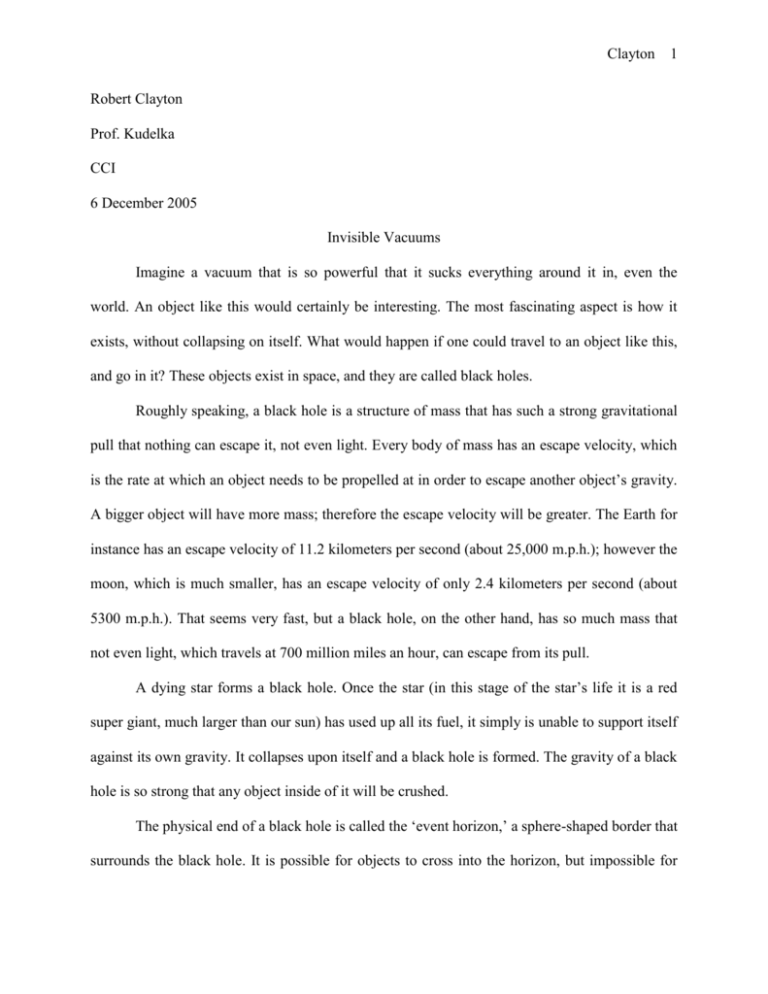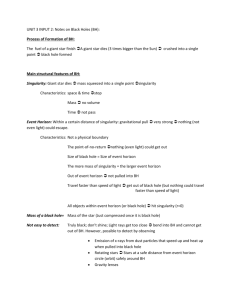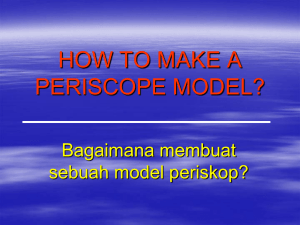Robert Clayton
advertisement

Clayton 1 Robert Clayton Prof. Kudelka CCI 6 December 2005 Invisible Vacuums Imagine a vacuum that is so powerful that it sucks everything around it in, even the world. An object like this would certainly be interesting. The most fascinating aspect is how it exists, without collapsing on itself. What would happen if one could travel to an object like this, and go in it? These objects exist in space, and they are called black holes. Roughly speaking, a black hole is a structure of mass that has such a strong gravitational pull that nothing can escape it, not even light. Every body of mass has an escape velocity, which is the rate at which an object needs to be propelled at in order to escape another object’s gravity. A bigger object will have more mass; therefore the escape velocity will be greater. The Earth for instance has an escape velocity of 11.2 kilometers per second (about 25,000 m.p.h.); however the moon, which is much smaller, has an escape velocity of only 2.4 kilometers per second (about 5300 m.p.h.). That seems very fast, but a black hole, on the other hand, has so much mass that not even light, which travels at 700 million miles an hour, can escape from its pull. A dying star forms a black hole. Once the star (in this stage of the star’s life it is a red super giant, much larger than our sun) has used up all its fuel, it simply is unable to support itself against its own gravity. It collapses upon itself and a black hole is formed. The gravity of a black hole is so strong that any object inside of it will be crushed. The physical end of a black hole is called the ‘event horizon,’ a sphere-shaped border that surrounds the black hole. It is possible for objects to cross into the horizon, but impossible for Clayton 2 them to cross out. It is easiest to think of the horizon as a place where the escape velocity equals the speed if light. Even if something is less than a millimeter away from the horizon, it can still get away if it has enough force to. Of course the only thing that would be able to get away that close to the horizon is light, but it is still possible. However, as soon as an object crosses the horizon, its fate is sealed. Not even light would be able to escape. The horizon is a complicated entity. If someone were able to get close enough without being in danger, they would view it as an unmoving object, however; once you get into the horizon, you would see that the horizon is actually moving outward at the speed of light. This helps to explain why you can cross into it, but not out. A black hole is a big object. It is big in two ways: mass and size. Mass is how much something weighs, while size determines how much space it takes up. There is no limit to the amount of mass that can be made to form a black hole. Black holes are formed from the death of a massive star, but the Conservation of Energy law states that no mass can be created or destroyed in a reaction, so it is suspected that a black hole will have the same amount of mass as the star from which it died. Let’s say that the mass of a star was around ten times the amount of our sun’s mass (a solar mass), which would be 1031 kilograms. Some of the heaviest black holes lay at the center of some galaxies and those black holes weigh up to a million times the solar mass, 1036 kilograms. The mass a black hole contains is directly proportionate to the radius of its horizon. For example if one black hole weighed five times as much as another black hole, its horizon’s radius would be five times as big. It works in terms like this: if a black hole had a solar mass, it would have a radius of three kilometers. A ten solar mass black hole would have a radius of thirty kilometers and a thousand solar mass black hole would have a three thousand kilometer radius. Clayton 3 By comparison, the radius of the Earth is 6 378.1 kilometers, so some black holes are about half of the Earth’s size, but they are so dense they would crush the Earth in seconds. Many people wonder what would happen if they took a spaceship into a black hole. They wonder if it would be an instant death or if they would experience the gravity for a while. For an example, let’s use a black hole that has a million solar mass. A million solar mass black hole is a prime example, because a smaller black hole would crush you before you could really feel its effects. If you were far enough away from the horizon at first, you wouldn’t feel anything because although the hole is pulling you in, pull is not that strong so you wouldn’t feel it. Everything that would be around (your body, your ship and everything in it) would be pulled the same way at the same rate, so you’d feel weightless. Eventually, you’d feel a “tidal pull,” which can best be described like this: If your feet were closer than your head (to the center of the hole) then they would be getting more of a pull, leaving you with a stretched feeling. You can get the same affect if you spin very fast in a circle. Although it wouldn’t be nearly to the degree of a pull that a black hole would have, it is a decent simulation. Your vision would be fine. You’d see some objects that are slightly distorted because the hole’s gravity bends light. Even as you cross the horizon, you would be able to see out. This is because there would still light coming into the hole. No one could see into the hole because the light is not strong enough to get out. However, you wouldn’t really have time to think about that kind of stuff, because seven seconds after crossing the horizon, the tidal pull would get so strong on your body and ship that it would crush you both. Something like that would be sure to but a damper on someone’s day. If someone were watching you fall into a black hole, they would get quite a different view. The closer and closer you get to the horizon, the slow and slower they would see you Clayton 4 move. This is because the light would take longer to escape the pull because it is so close to the horizon. The person watching would never see you actually cross the horizon, which is why the holes were originally called frozen stars, because the object seemed to “freeze” just before it crossed the horizon. The light you’d emit would never reach anyone because it would be suspended at the horizon. Earlier, it was mentioned that the escape velocity at the horizon is the speed of light. The light is not strong enough to fully get out, but not weak enough to get sucked in. You have long since passed into the horizon and dead by now, but the light being sent to the person who observed it, telling them that you crossed the horizon would never reach them. Another common question that people have is that since a black hole is the remnants of a dead star, will the sun eventually become a black hole? Scientists don’t think the sun will follow that path. They think that the sun will just burn itself out. Before either of these happen, however, the sun will become a super giant, which means life on Earth won’t be possible. The sun will become so big that it will engulf Mercury and Venus, making Earth the closest planet to the sun. The water will all evaporate and the atmosphere will crumble. There is good news in all this though, this all isn’t supposed to happen for another five to eight billion years, so there is nothing to worry about now.








